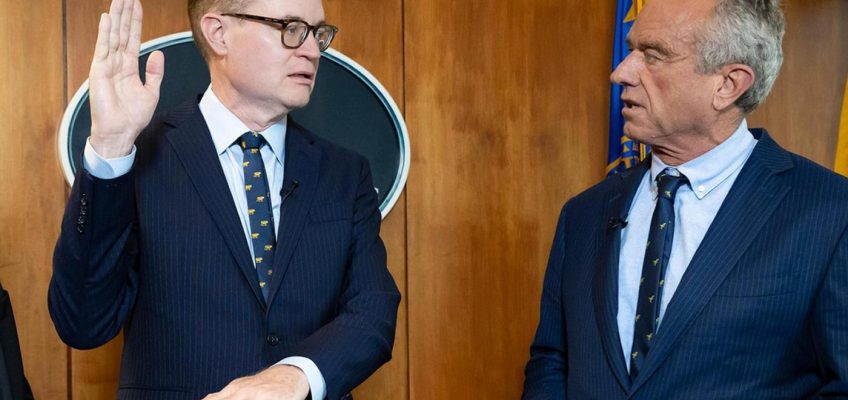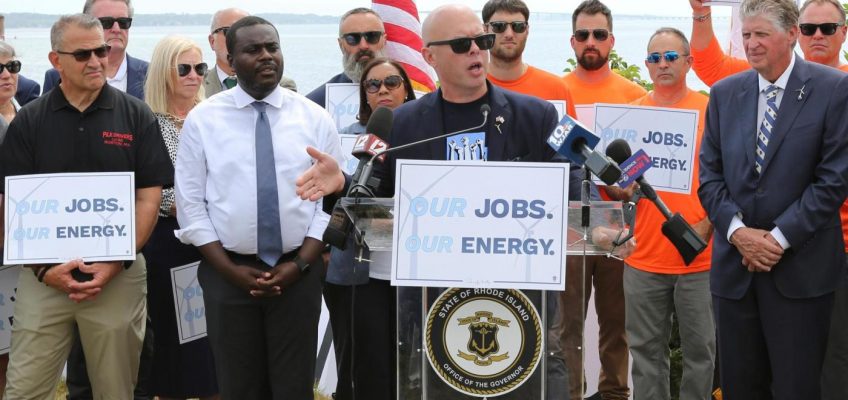By MATTHEW PERRONE, Associated Press
WASHINGTON (AP) — President Donald Trump has picked Jim O’Neill, a former investor and critic of health regulations serving under Health Secretary Robert F. Kennedy Jr., to take control of the Centers for Disease Control and Prevention, following a tumultuous week in which the agency’s director was forced out.
O’Neill, Kennedy’s deputy at the Department of Health and Human Services, will supplant Susan Monarez, a longtime government scientist who had been the CDC director for less than a month.
Monarez’s lawyers said she refused “to rubber-stamp unscientific, reckless directives and fire dedicated health experts.”
O’Neill takes over as acting director of an agency that has been rocked by firings, resignations and efforts by Kennedy to reshape the nation’s vaccine policies to match his long-standing suspicions about the safety and effectiveness of long-established shots.
An HHS spokesperson said Friday that O’Neill would continue to serve as deputy of the department but did not provide details on his new role.
A former associate of billionaire tech entrepreneur Peter Thiel, O’Neill previously helped run one of Thiel’s investment funds and later managed several of his other projects. Those included a nonprofit working to develop manmade islands that would float outside U.S. territory, allowing them to experiment with new forms of government.
He has no training in medicine or health care and holds bachelor’s and master’s degrees in humanities.
A Washington insider on a team of outsiders
O’Neill has kept a markedly lower profile than Trump’s other top health officials, who all joined the administration as Washington outsiders. He’s also the only one with experience working at HHS, where he served for six years under President George W. Bush.
Those who know him say he’ll likely be tasked with trying to calm the situation at CDC — though it’s unclear what, if any, independence he’ll have from Kennedy.
“Jim O’Neill is a health care policy professional and I don’t think anybody can accuse him of being an RFK Jr. sock puppet,” said Peter Pitts, a former FDA official under Bush. “The question becomes whether the role of CDC director becomes a strictly paper tiger position, where the person only does what they’re told to by the secretary.”
O’Neill is not closely associated with Kennedy’s “Make America Healthy Again” movement and its efforts against food dyes, fluoride and ultraprocessed foods.
He was also not a major critic of public health measures during the pandemic, unlike Food and Drug Administration chief Marty Makary and other Trump officials. Although O’Neill did use social media to criticize FDA efforts to stop the prescribing of unproven treatments for COVID-19, including the anti-parasite drug ivermectin.
O’Neill has pushed for less regulation
O’Neill has long-standing ties to the libertarian wing of the Republican Party, including Thiel, one of Trump’s leading supporters from Silicon Valley. Like Thiel, O’Neill has expressed disdain for many parts of the federal bureaucracy, saying it hinders advances in medicine, technology and other areas.
During Trump’s first term, O’Neill was vetted as a possible choice to lead the FDA, although his past statements about the agency raised alarms among pharmaceutical and medical technology executives.
In particular, O’Neill proposed doing away with FDA’s 60-year-old mandate of assuring new drugs are both safe and effective in treating disease. In a 2014 speech, O’Neill suggested drug effectiveness could be established after they hit the market.
Trump ultimately nominated Dr. Scott Gottlieb, a former FDA official and supporter of the agency’s regulatory approach, as commissioner.
Refusal to break with Kennedy on vaccines
After being nominated to the HHS post, O’Neill voiced his support for the federal government’s traditional system for overseeing vaccines — including the role of the CDC — while refusing to criticize Kennedy’s views on the topic.
“I support CDC’s recommendations for vaccines,” O’Neill told Louisiana Republican Sen. Bill Cassidy at a confirmation hearing in June. “I think that’s a central role that CDC has. It’s mandated in law.”
In follow-up questions, ranking Democrat Ron Wyden pressed O’Neill on statements by Kennedy downplaying the safety and effectiveness of vaccines to prevent measles and other diseases.
“Secretary Kennedy has not made it difficult nor discouraged people from taking vaccines,” O’Neill responded.
High-stakes vaccine decisions ahead
Within weeks, O’Neill could be asked to sign off on new recommendations from a CDC panel that Kennedy has reshaped with vaccine skeptics. The group is scheduled to meet next month to review vaccinations for measles, hepatitis and other conditions that have long been established on the government schedule for children.
Traditionally, the CDC director signs off on recommendations from the panel. But Monarez was ousted after, among other things, she refused to automatically sign off the committee’s recommendations, according to Dr. Richard Besser, a former CDC acting director who spoke to her.
As an acting official, federal law limits O’Neill to no more than 210 days heading the agency before he must step aside or be formally nominated to the post.
Dr. Anne Schuchat, who served twice as acting CDC director, says there are essentially no limits on the powers of the acting agency chiefs, beyond the time constraints.
“I was told, ‘You’re the director. Do what you need to do,’” Schuchat said.
Trump admin cancels $679 million for offshore wind projects as attacks on reeling industry continue
US revokes visas of Palestinian officials ahead of UN General Assembly
Judges, defense lawyers and grand jurors poke holes in cases from Trump’s DC federal intervention
Trump administration tells states to remove references to ‘gender ideology’ from sex ed materials
As Trump threatens more Guard troops in US cities, here’s what the law allows
Dueling health roles
Both of O’Neill’s roles at HHS and CDC are demanding, full-time jobs that would be extremely challenging for one person to do simultaneously, Schuchat said.
“But if the goal is to have an acting CDC director fulfill a predetermined decision about vaccines, it’s a different story,” Schuchat said.
It won’t help O’Neill that there was an exodus this week of four veteran CDC center directors, leaving the agency with few leaders who have a background in medicine, science or public health crisis management, she added.
AP Medical Writer Mike Stobbe contributed to this story from New York
The Associated Press Health and Science Department receives support from the Howard Hughes Medical Institute’s Department of Science Education and the Robert Wood Johnson Foundation. The AP is solely responsible for all content.




